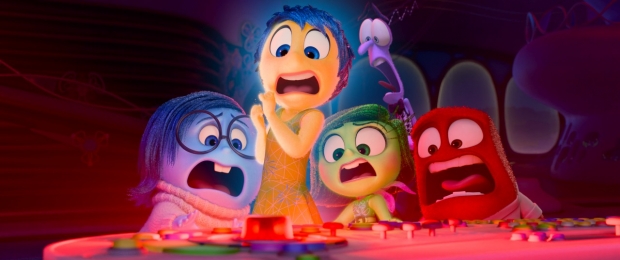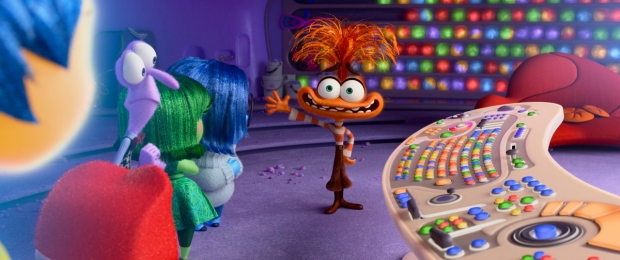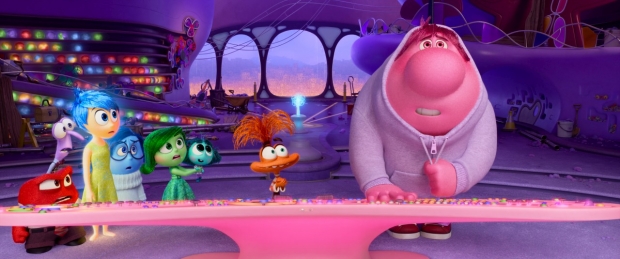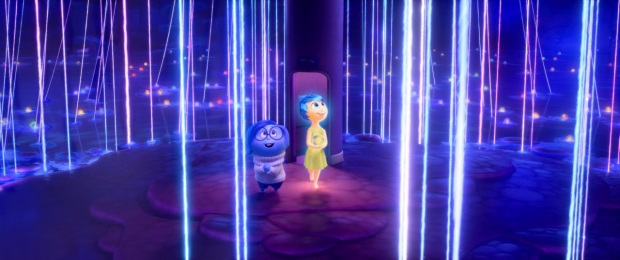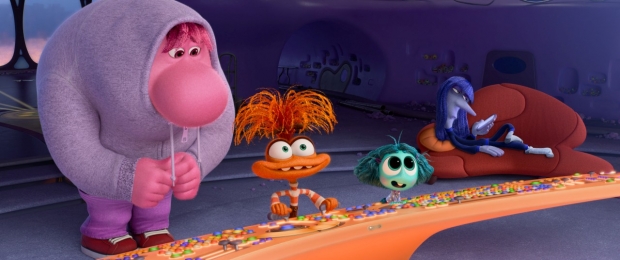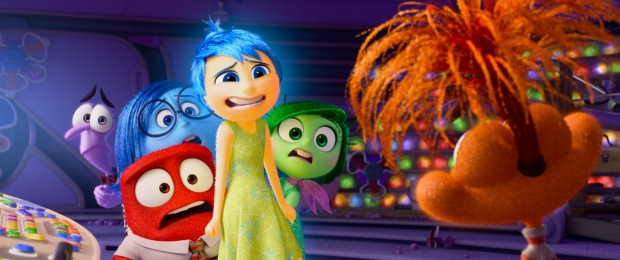The director and producer discuss their new film, the feel good / sad / angry / anxious movie of the summer, Pixar’s highly anticipated sequel to Pete Docter’s Oscar-winning 2015 ‘Inside Out;’ the emotions are back… with new digs and unexpected guests, coming to theaters June 14.
It’s been nine years since Pixar released Pete Docter’s brilliantly funny and inventive animated comedy, Inside Out. The 2015 film earned more than $850 million globally and went on to garner numerous awards including an Oscar. It introduced audiences to what goes on inside the mind of a young girl, Riley, as she struggles with her emotions after moving with her family to San Francisco from Minnesota. Her coming-of-age story is told through the actions of her emotions: Joy, Sadness, Fear, Disgust and Anger.
Picking up the storytelling mantle in the next phase of Riley’s life are director Kelsey Mann and producer Mark Nielsen, now hard at work finishing up the studio’s long anticipated sequel, Inside Out 2. In the new 3DCG comedy, we fast forward to Riley as a newly minted teenager just as her emotional headquarters is undergoing a sudden demolition to make room for something entirely unexpected: new Emotions! Joy, Sadness, Anger, Fear, and Disgust, who’ve long been running a successful operation by all accounts, aren’t sure how to feel when Anxiety shows up. And it looks like she’s not alone.
In the film, Maya Hawke voices Anxiety, a new arrival bound to shake up everything. A bundle of frazzled energy, Anxiety enthusiastically ensures Riley’s prepared for every possible negative outcome. She’s joined by Envy, voiced by Ayo Edebiri, Ennui, voiced by Adèle Exarchopoulos, and Embarrassment, voiced by Paul Walter Hauser. The all-star cast also includes Amy Poehler as Joy, Phyllis Smith as Sadness, Lewis Black as Anger, Tony Hale as Fear, and Liza Lapira as Disgust. The film will be released exclusively in theaters on June 14.
What… Me Worry?
AWN recently visited Pixar to meet the filmmaking team and watch the first 30 minutes of the movie. Mann and Nielsen shared their thoughts on the film, including a significant early change in the story and how it can be tough to cut really funny material in scenes that run too long – abiding by the adage that less is usually more.
Dan Sarto: Inside Out, pound for pound, was one of, if not my most favorite Pixar film. When I first heard of the sequel, I thought, “Okay, let's see what the studio does with it.”
Mark Nielsen: A healthy dose of skepticism.
DS: Disney is in the news a lot lately, across so many parts of the company including animation… a sequel of this magnitude could go in any of several directions…
Kelsey Mann: Yeah. Totally.
DS: Inside Out is unique for many reasons including that the humor stems from the characters themselves, who they are, and not just what they're given to perform, or the gags they're given. Long story short, in the footage you showed last night, I immediately felt you deftly carried the tone, the DNA of the first movie into your film.
MN: That's awesome.
DS: And that spoke to me. 98% of the animation I deal with, it's not made for me specifically as an audience, which is fine.
KM: I hear you.
DS: But your film is. What we saw, I thoroughly, thoroughly enjoyed. It feels like a return to form, the Pixar that has been celebrated as the gold standard in animation for so many years. But it's a much more crowded field now.
KM: Yeah, it certainly is.
DS: There are a lot of good filmmakers and a lot of good films. But this type of film, done this way, is a Pixar film, and this was always what set you guys apart. It was really good to see that again.
KM: Thank you for that. I must give props to a lot of people, obviously, but a big part of that is Meg LeFauve. She was a writer on the first film… and she was the first person [on this film]. It was just the three of us for the longest time. Her big thing is making sure that the humor is always coming from the characters. I hope she reads this and hears that because that'll warm her heart. She works hard at it.
DS: We all like funny stuff. We like funny gags when they hit. But there's stuff that's funny because the characters themselves are inherently funny. They can't help but be funny. It might just be a funny expression or look…
KM: Yeah. Totally.
DS: How long did it take you guys to arrive at the main story, going from Riley and a ukelele [info shared during a junket presentation] to Riley playing hockey?
KM: Well, there was first a talent show.
MN: Screening one.
KM: That was screening one. That particular part lasted a couple screenings. I remember early on… we figured we should lean into the specificness of what makes Riley unique. She plays hockey, and it's this unique thing. She’s a sports girl.
MN: Screening two or three probably is where we threw that switch.
KM: There are a lot of stories about teenagers and teenage girls. But how do we find a specific one that's unique and different? Even within our own walls… Domee Shi made Turning Red, which was about a girl becoming a teenager, too. I remember talking to Domee and I'm like, “I think I want to have Riley become a teenager because it was so perfectly set up at the end of the first film. It feels like what the next one should be.” I said to her, “I want to make sure I'm not in your lane at all.” She goes, “Kelsey, first of all, that movie is about me and my mother. Also, there are lots of different experiences 13-year-old girls have and we didn't tell a story about the only one.” I was like, “All right!” I relaxed. We leaned into what makes Riley unique and different, and her being into hockey was definitely a unique thing.
DS: There are significantly more humans and human character storytelling in this film than the first, which poses a different type of challenge. It's harder to innovate with design, especially with the tone of the film. Animating human characters, well, everyone’s doing that. Including Pixar in films like Lightyear. Is that tougher to do than what I'll call the “cartoony” animation, for want of a better phrase? Was that as hard or harder than the other parts of the film?
KM: It definitely was a thing that was set on the first movie. The outside world was done a little bit more “realistic and traditional,” while the inside was really pushed and cartoony. I remember Pete even saying to me early on, “There's a difference between the two.” He goes, “I thought we went really broad with the animation inside the mind.” He even showed me a couple shots. He was like, “Here's what I think worked really well.” I think it was Joy playing the accordion and waking the characters up.
MN: Yeah. We really pushed the animation.
KM: Which was animated by Evan [Bonifacio], by the way.
MN: Who's one of our animation supervisors.
KM: Yeah. He showed me the shot. He goes, “This is what I think you should go for.” In fact, at the time, I thought I went too far with it. But looking back, I didn't go far enough. He's like, “Push it even further.” I remember telling the whole animation department when we were pitching them the movie that we're like, “We want to push it even further.” But, to your original question, is one harder than the other? I don't know if one is harder than the other. But the world outside, it's harder to cheat. Where on the inside, we can do a real blurred character. There are some really cool frames. I would highly recommend seeing some of the paused images of anxiety moving around. It's really cool what they can do with 3D animation now that emulates 2D, like a smeared Looney Tunes cell. But I'm really excited with what the team has been able to accomplish on this movie, especially the animation team.
DS: One of the things with gags and humor is that you can overstay your welcome. Something goes from funny to not funny very, very quickly. One of the funniest things from the first film was showing the emotions in the parents’ heads. Quick. Short. In your film, you go back there. But quickly. You didn’t dwell. Beat a good thing to death. When you're in the early stages, how do you know when you’ve gone to the well once too often? Where any more will spoil things.
MN: In the dinner scene in the first film, where we go into Mom and Dad's heads and Riley's head, people loved that scene. It was one of the first scenes that we produced. A lot of people were like, “We want more of that in the movie.” But you can't have 90 minutes of that. It's too much. You're right, you have to have just the right amount of seasoning in the soup.
KM: You know, a really good example is we had a lot of fun with the sequence called the “Vault” where they all get locked up in the secrets area. That afforded so much great gags.
DS: It is really funny.
KM: I’m so proud of that scene because it came out of the gates that way. When we had the idea, it was one of those things where when we started talking about it, everybody goes, “Yeah, and then... and then...” The ideas just kept flowing out. The scene is hilarious. And, originally, it was really long.
MN: It was much longer than it is currently.
KM: The hardest thing about the vault sequence was cutting it down. And we kept pulling things out.
MN: Things that were really funny got pulled out.
KM: Yeah, we kept trimming stuff out. We would cut too close to the bone and I'm like, “You guys, I really miss him saying, ‘Hey, kids, let's learn some Latin. Do you know quid pro quo?’” It was out and I'm like, “I miss it. Please, we have to put it back.” Which meant that I had to take something out from another area. That was a hard one because it was just too long and slowed down the movie. I think we took a minute and a half out of it.
MN: Yeah, we did.
KM: Of really funny stuff.
MN: Hopefully, that scene is at its fighting weight right now.
DS: It felt pretty tight.
MN: That's great.
KM: That's amazing. Please tell Maurissa [Horwitz], our editor, that. That will warm her heart.
DS: I just interviewed Maurissa. One question I asked her she answered, “You might want to ask Kelsey that, also. Because I can't speak for him."
KM: What is it?
DS: The question was, “How often did you show Kelsey different edits?” Suggestions that changed your mind about a scene. I asked her if she wants to provide other options, does she come with a different edit in her pocket, so to speak.
KM: I can't even count the number of times. Here's a typical edit session. We all come in, okay, we're here to look at the whatever sequence it's called. Then Maurissa is like, “Kelsey, I have two cuts for you. I have it the way it was scripted, but I had to make this a little bit shorter. I took 30 seconds out. Which one do you want to start with?” I'm like, “Start with yours.” Because I want to watch her gut. I want to see if I miss anything in her edit. Every time she would always ask me, out of respect. But every time I would say, “Just play yours.”
MN: Because it was usually better.
KM: I trust her. I can't tell you how many times she did that. Right?
MN: We love that. That's such a great part of the collaboration that we experience with this crew. There are so many incredible filmmakers with great ideas, and you want to hear their take on things.
KM: It was always a back and forth. Sometimes I would miss it. I'd go, “I see why you did that, but I miss it.” Or “Can I see the other version?” Then I'd watch the other version and go, “Oh, I see. That doesn't quite work, but maybe if we change it like this, it will work.”
DS: I always love asking the producer this. Is your job ever to say no or just to say, “Yes, but...”
MN: As often as it can be, “Yes, but...” I love it to be that. I'd say most of the time you can get it there. But there are certainly times where the answer does have to be no. Just because there are real constraints on these films. I have been given a release date and a schedule that I've been asked to hit. I have been given a budget that's very specific that we need to stay within.
DS: Is it difficult to help arbitrate,“We can do that, but that means this?”
MN: Yeah. But I don't mind it so much. It's always been part of the job. Production management has always been my love in the film industry and has been the lane I've been in since I was a PA back in the early days on A Bug's Life.
That negotiation is something that's part of being in production management. It's okay if you're saying no to something and you deeply believe that it is the right call to make. Because what you're being asked for you don’t believe is going to be better for the film. I always say we work for the movie. Kelsey works for the movie. I work for the movie. We don't work for each other. What's the film need? You should all rally around that.
Dan Sarto is Publisher and Editor-in-Chief of Animation World Network.

